For a better experience, we recommend you to orientate your device
For a better experience, we recommend you to orientate your device

























































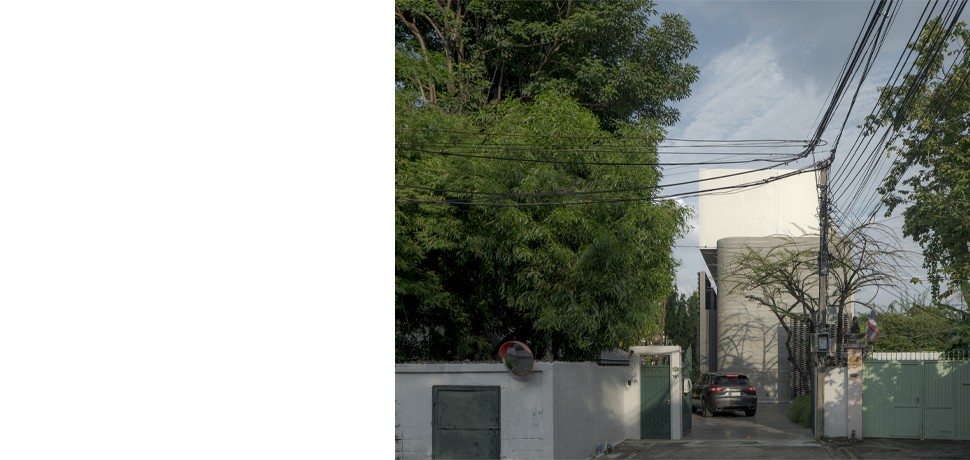
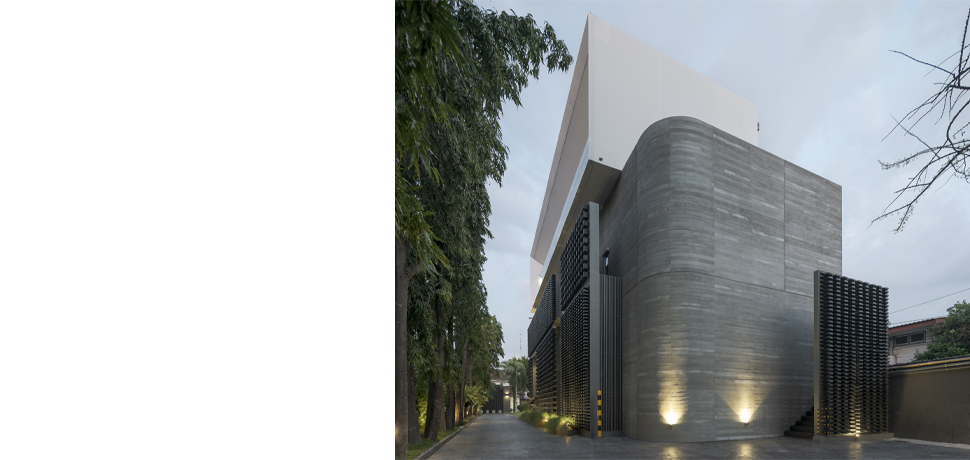
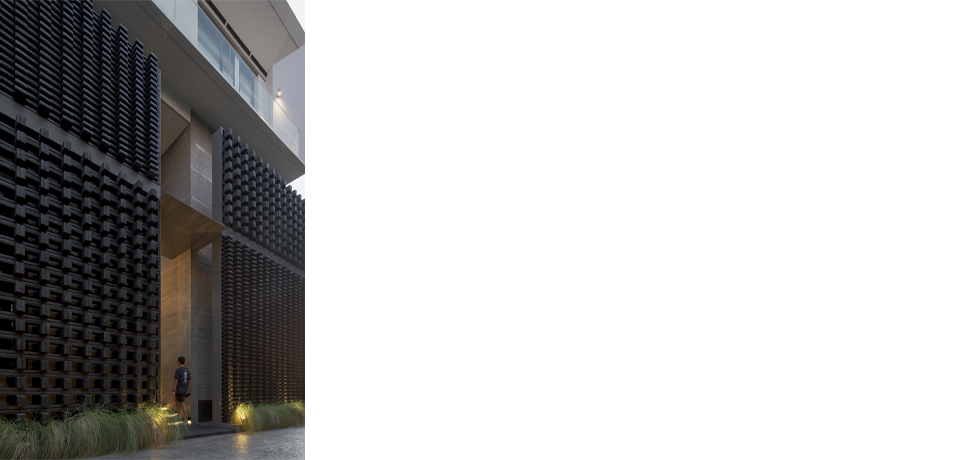

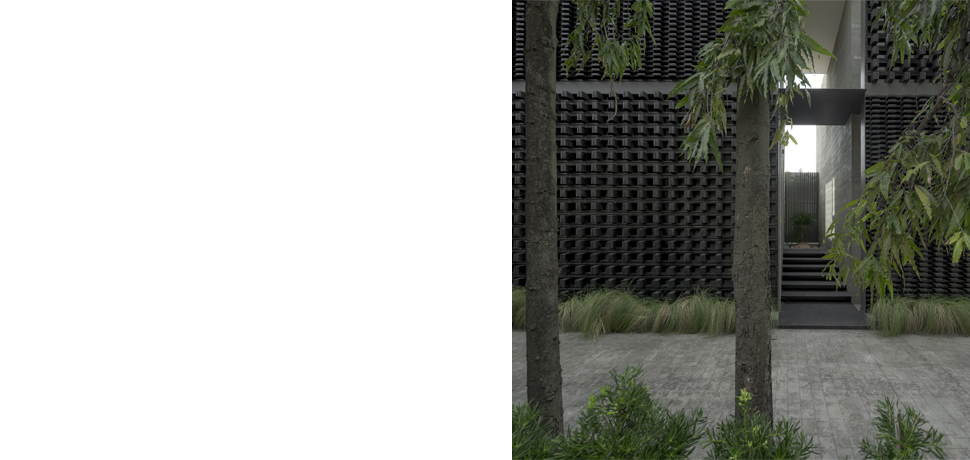

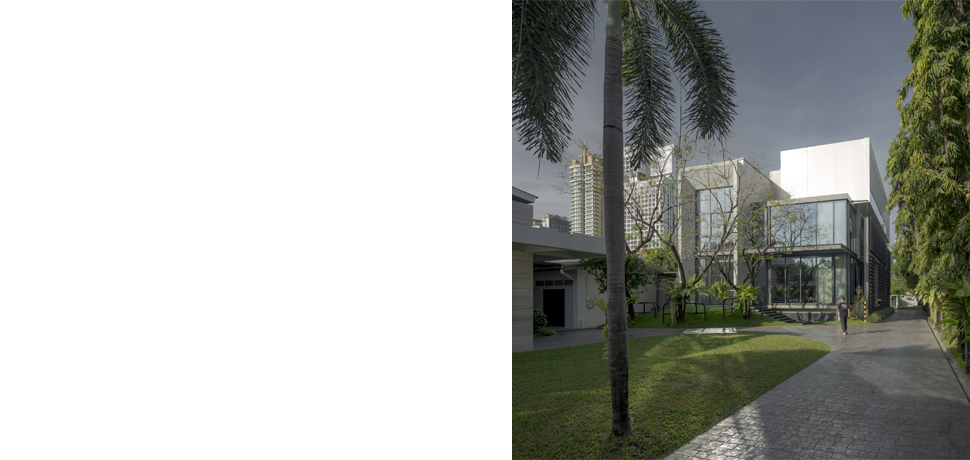
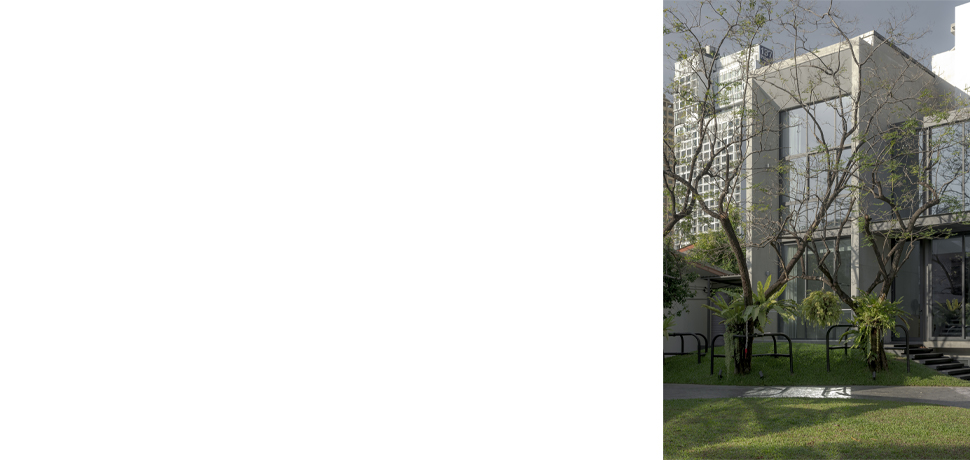
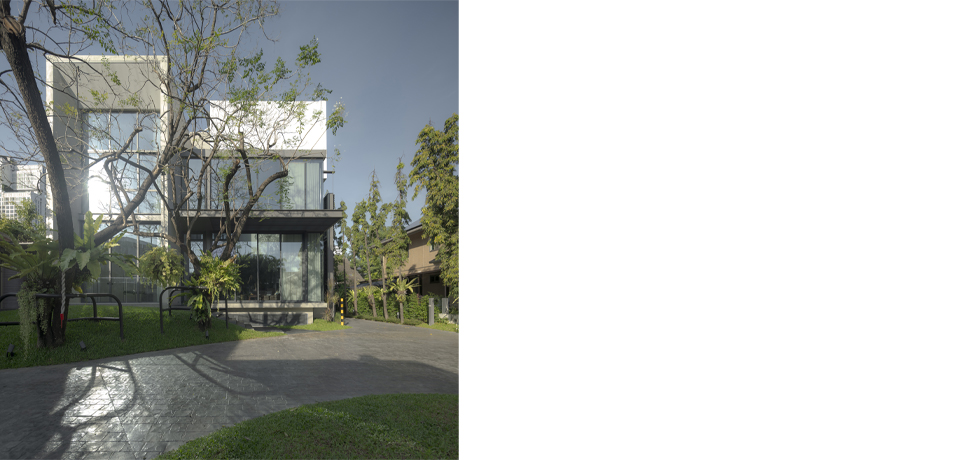
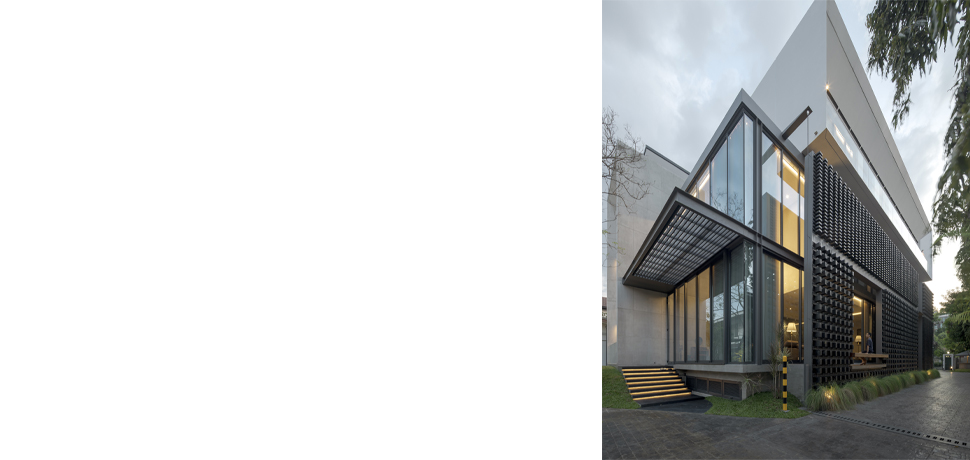
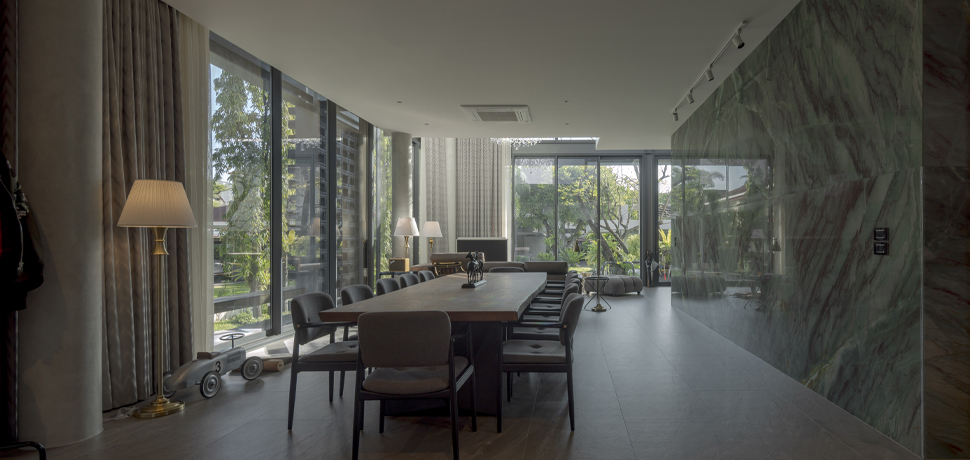
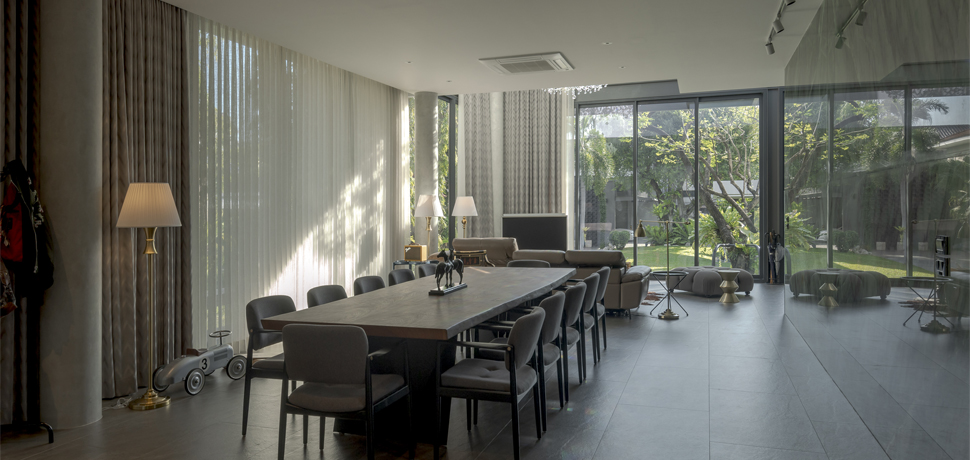
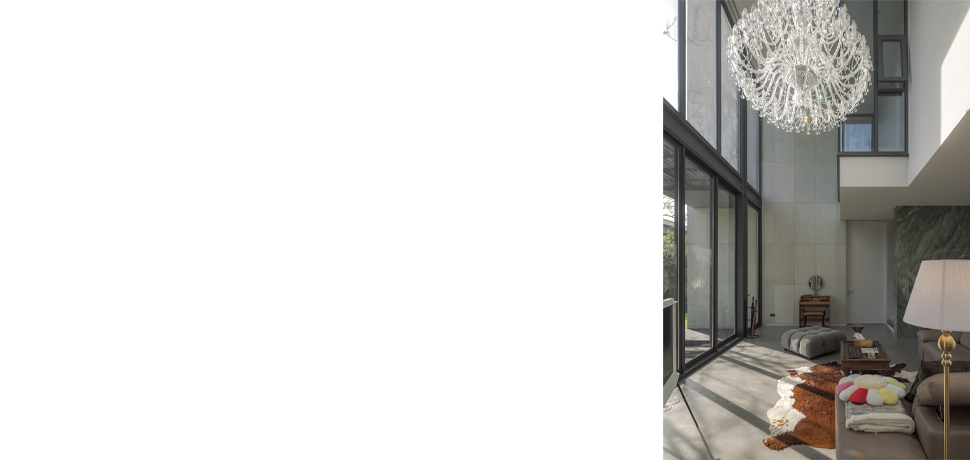
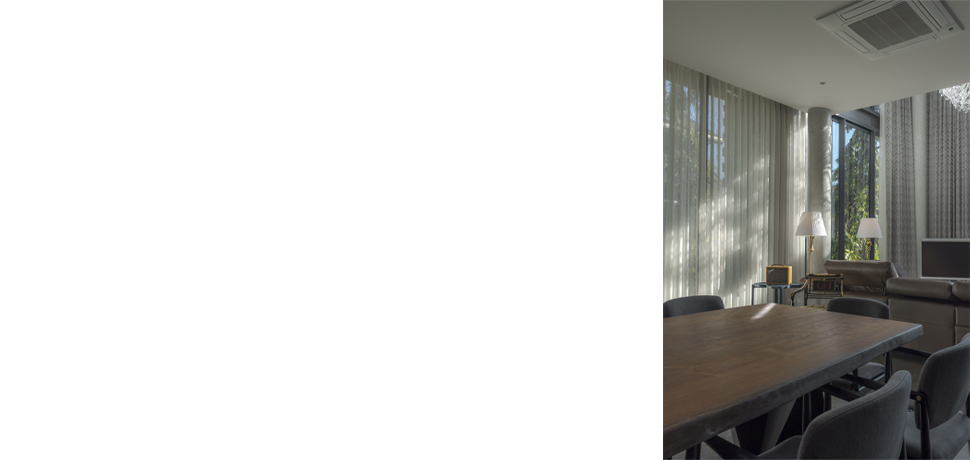
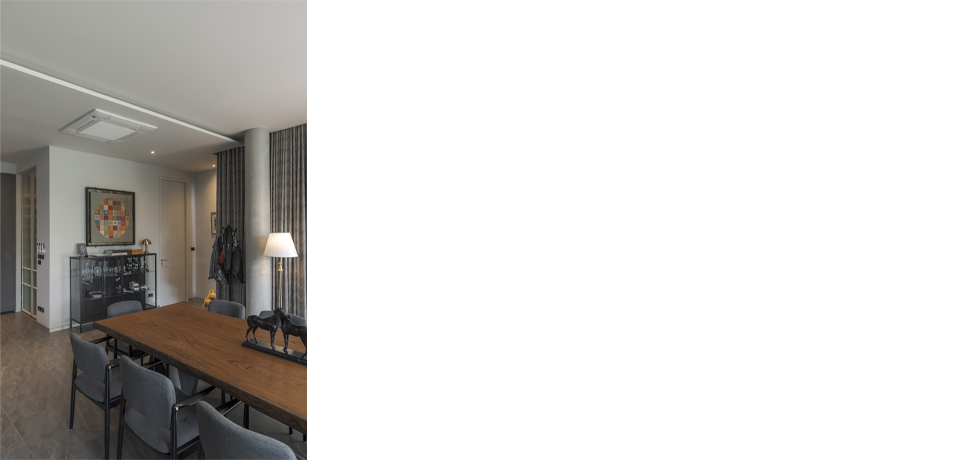
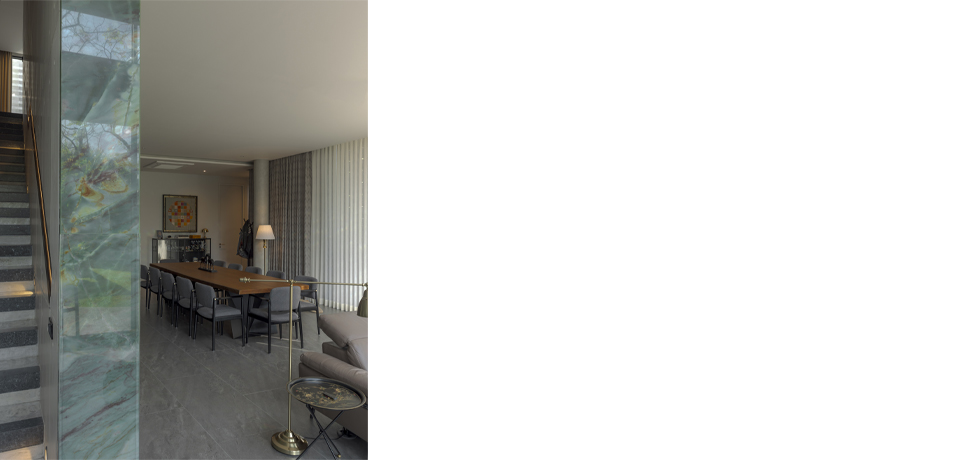
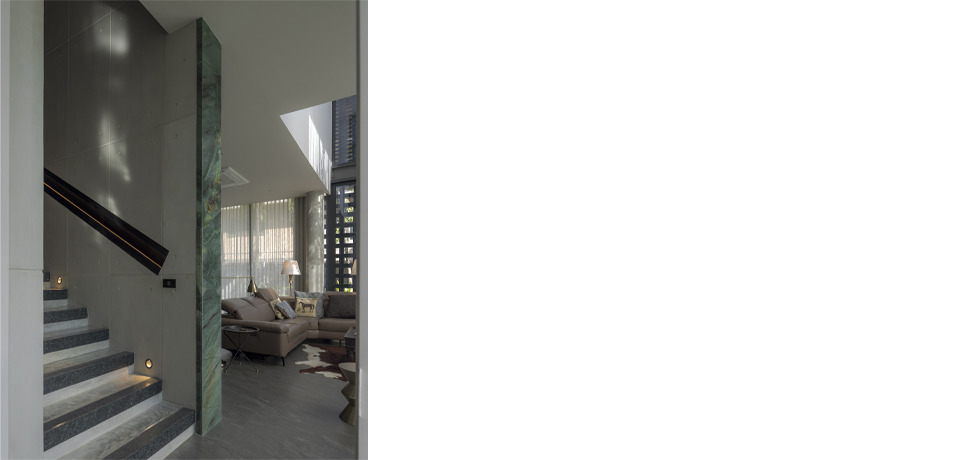
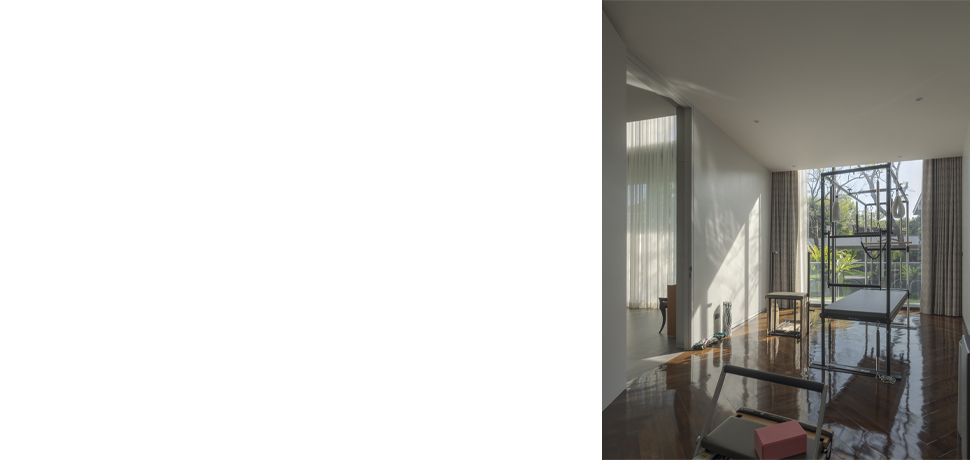
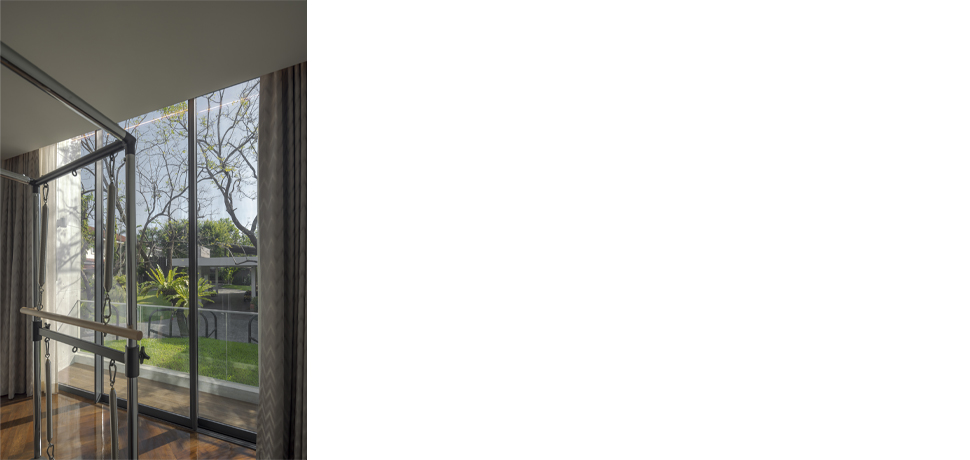
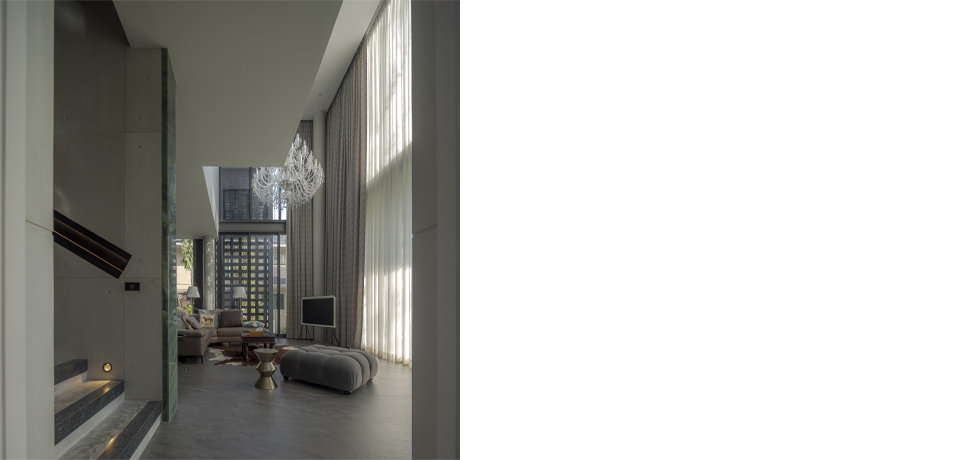
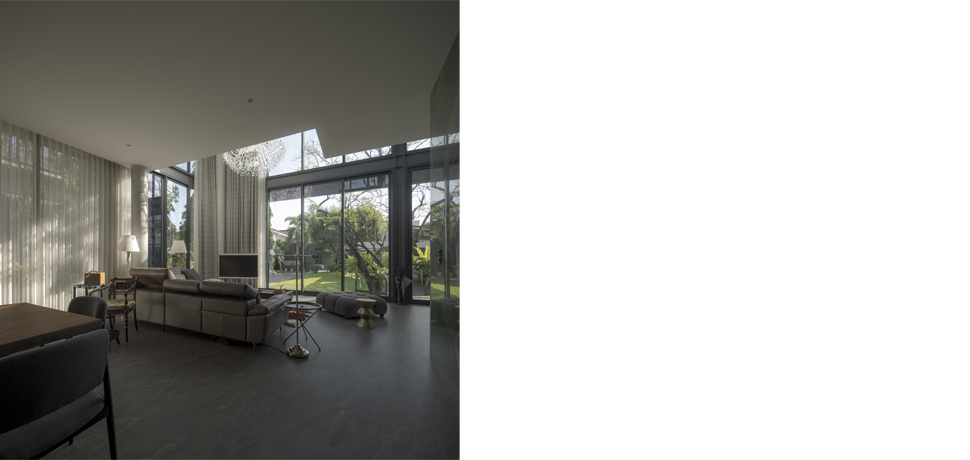
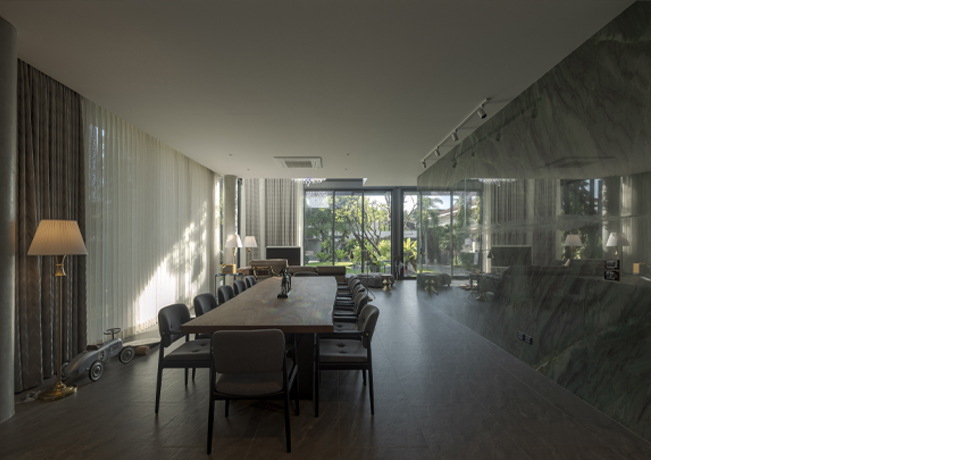
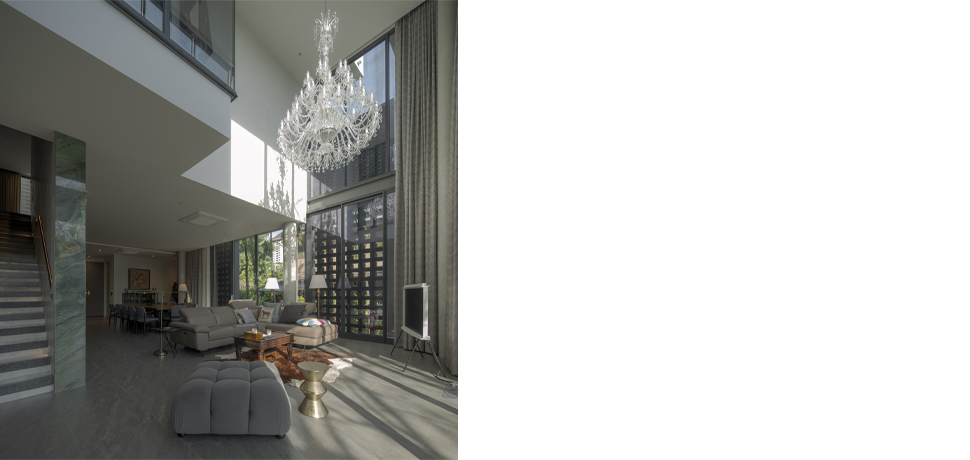
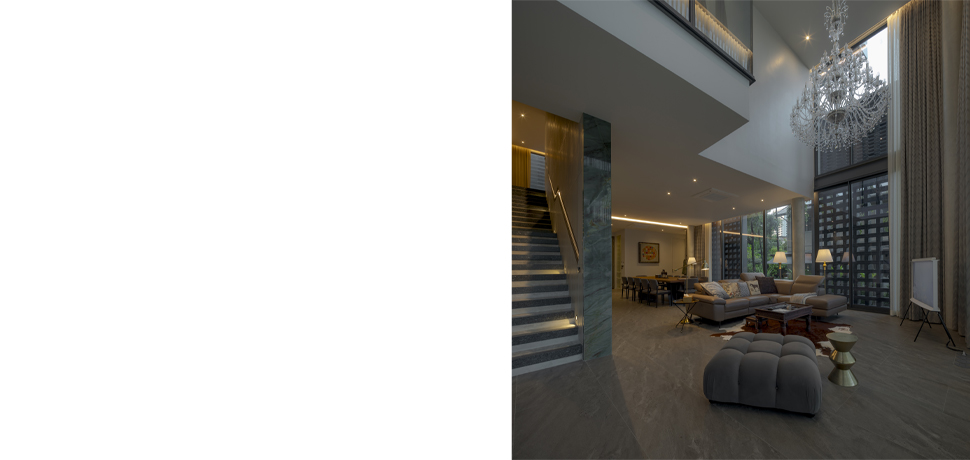
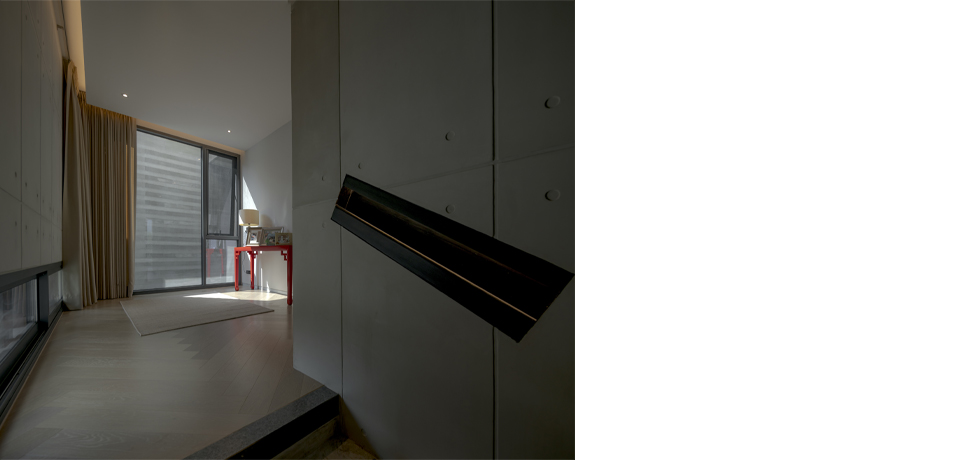
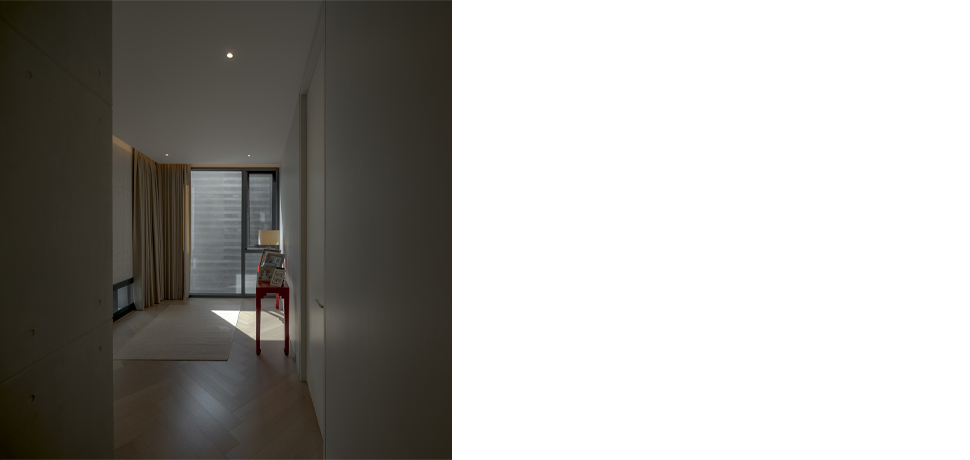
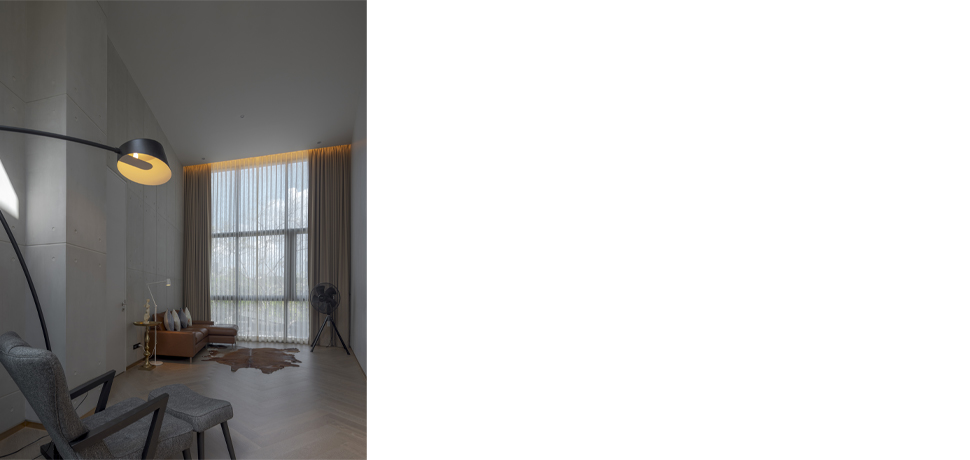
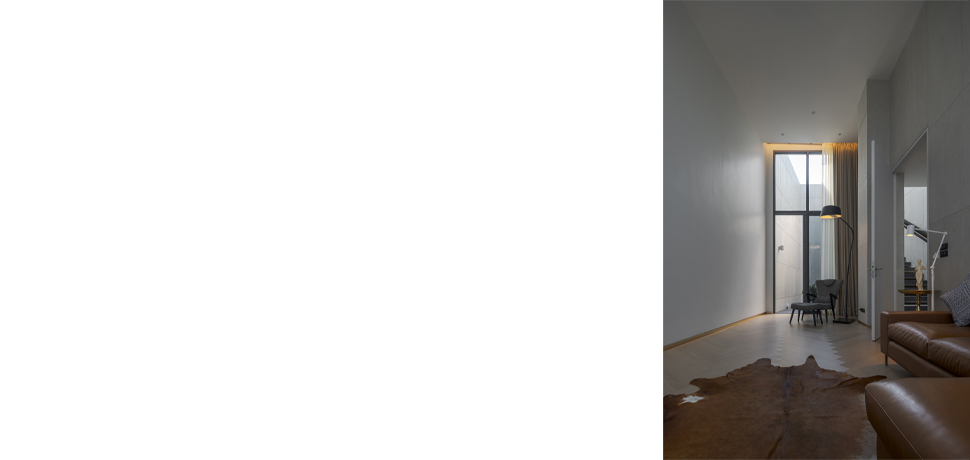
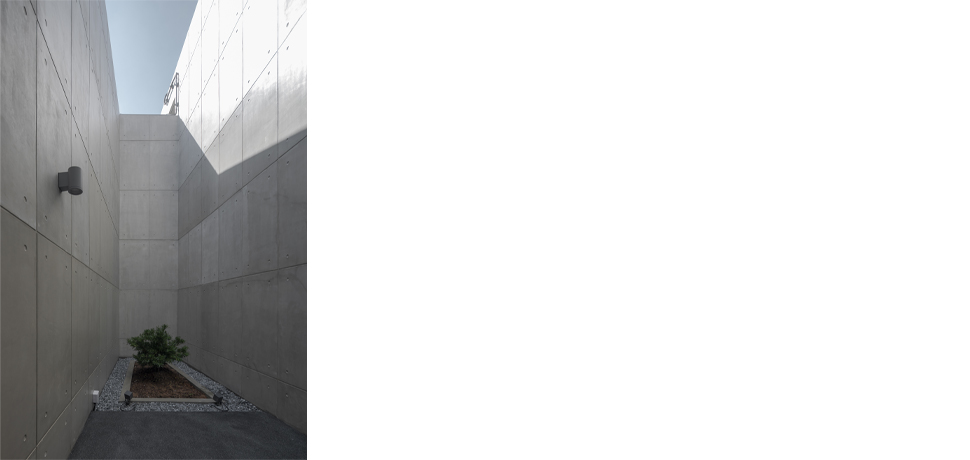
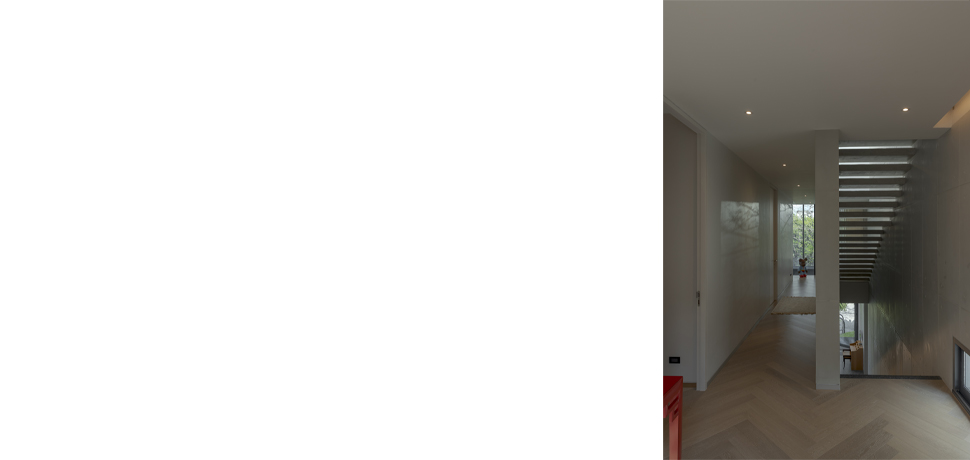

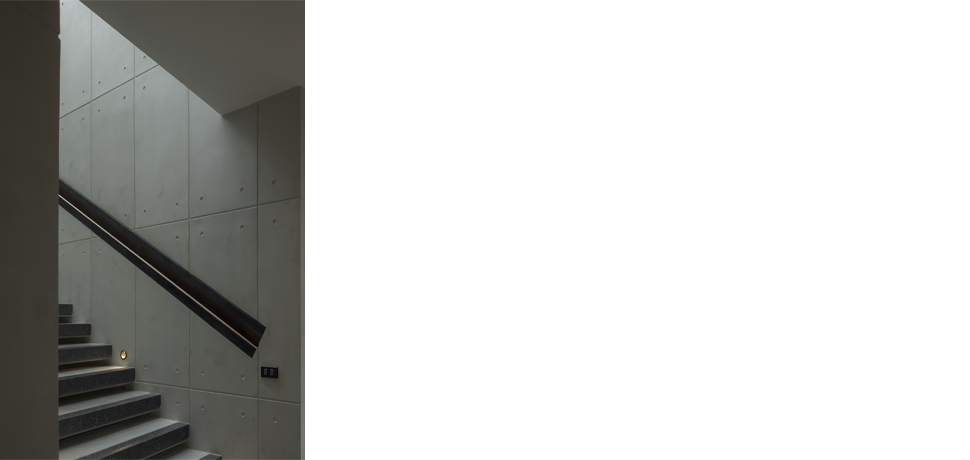
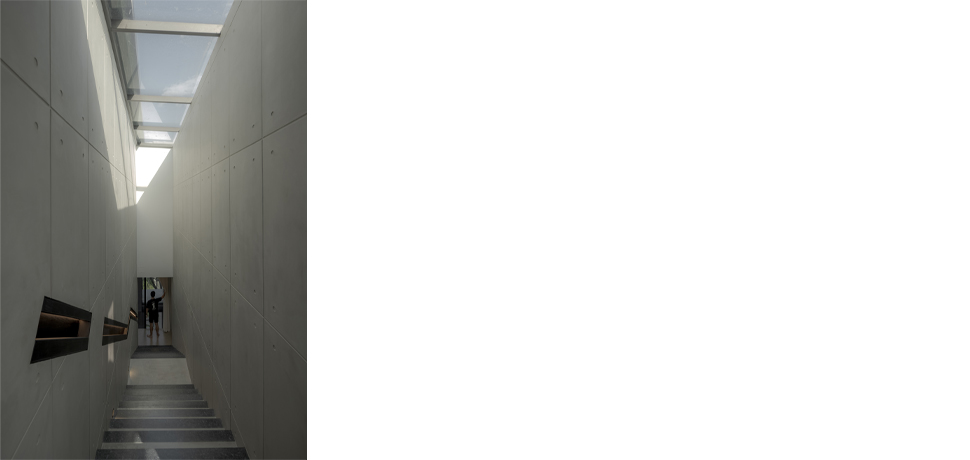
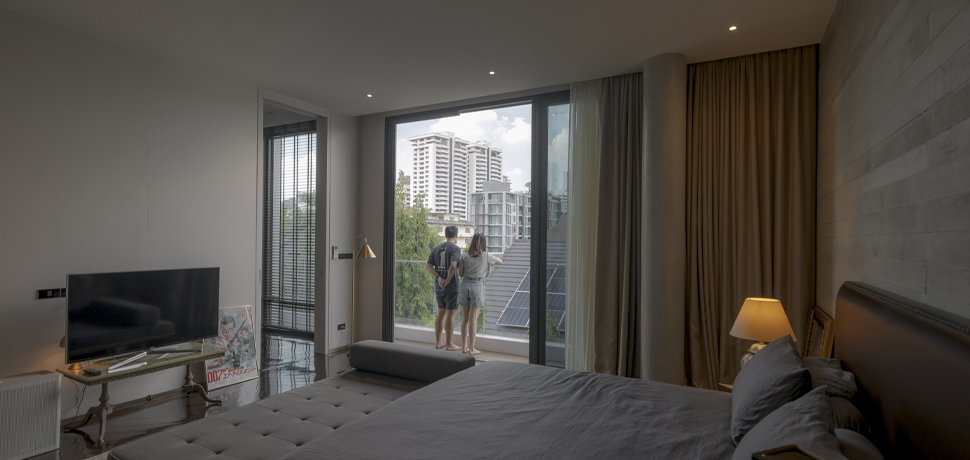
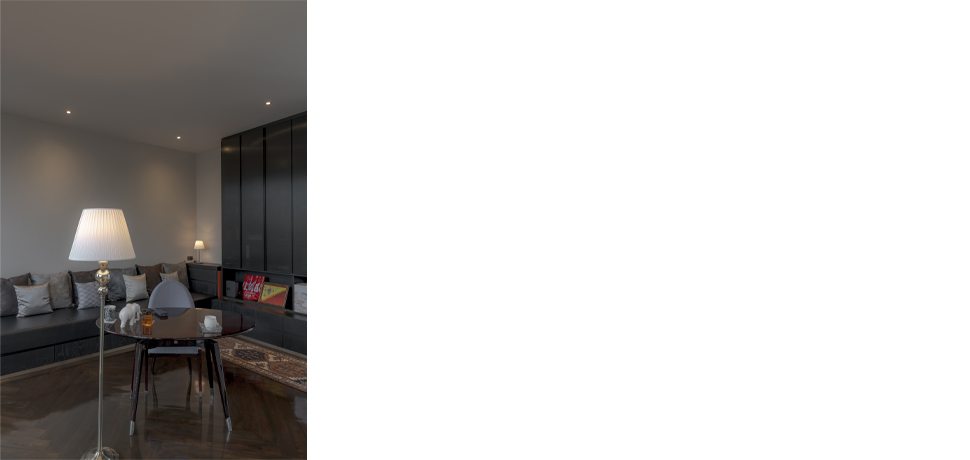
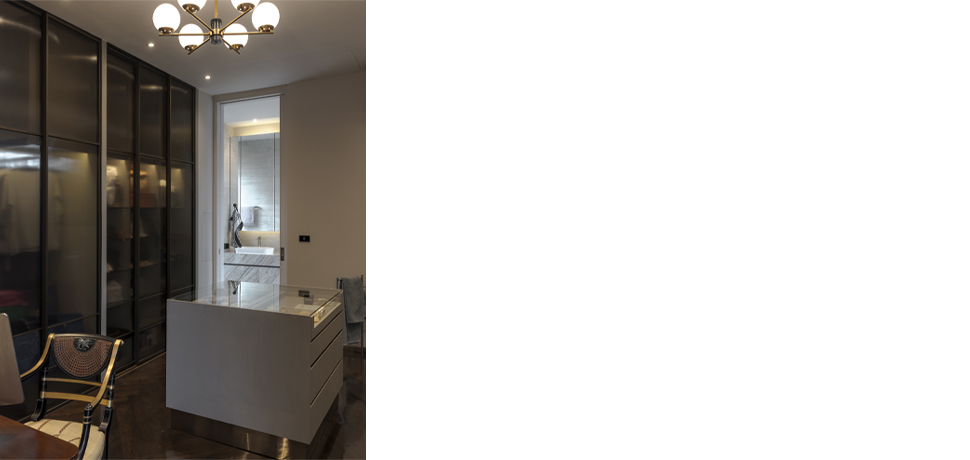
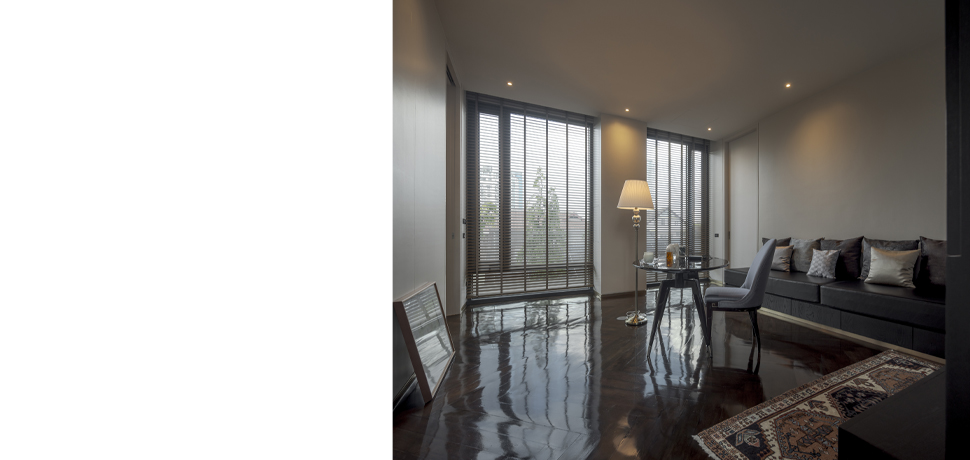
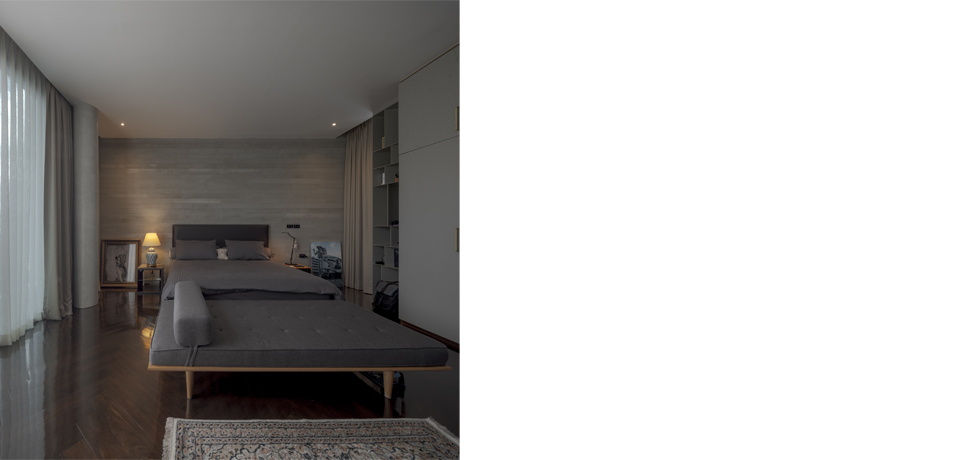
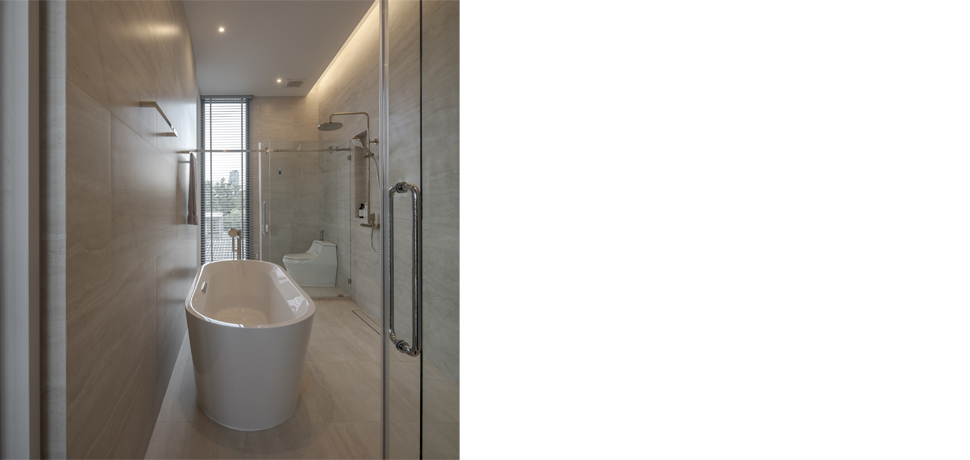
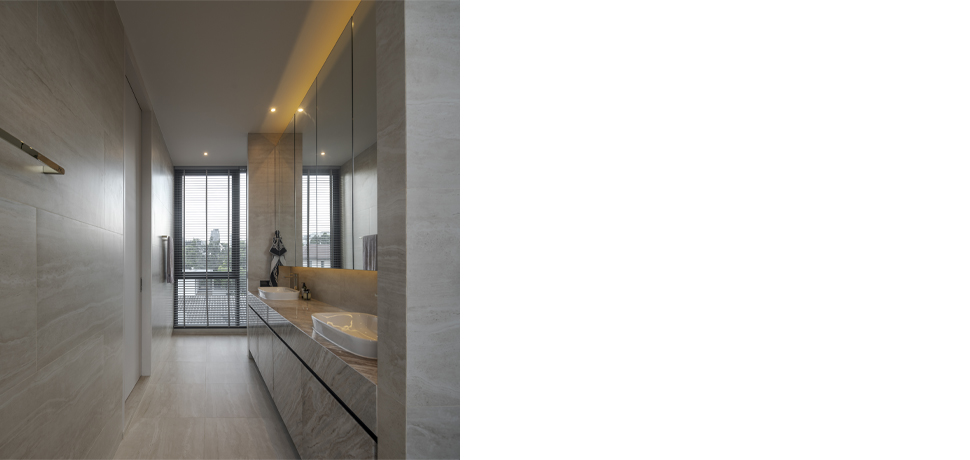
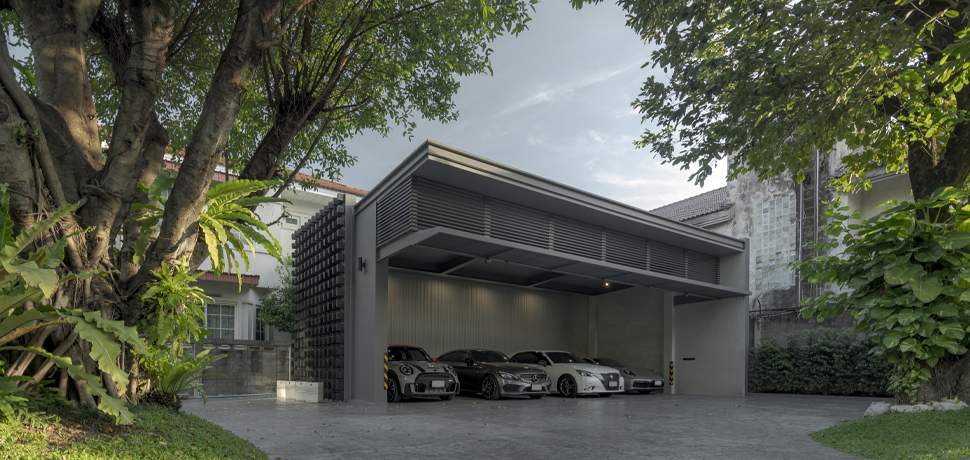
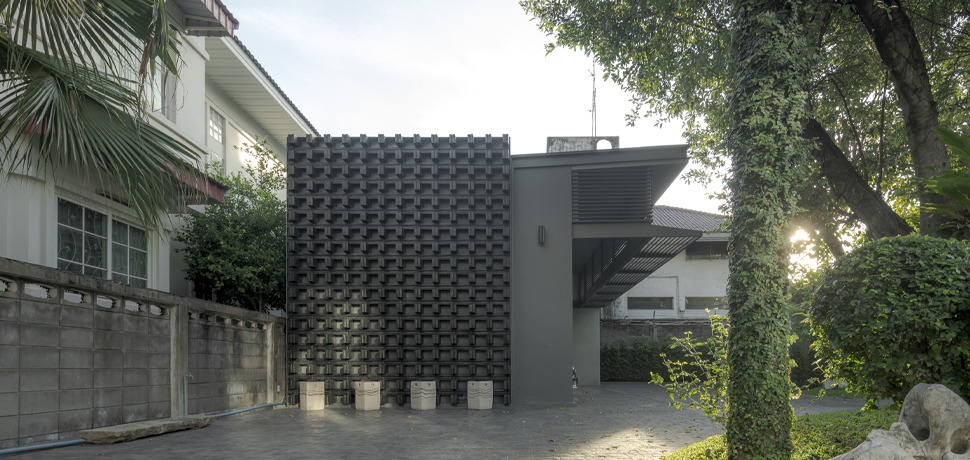
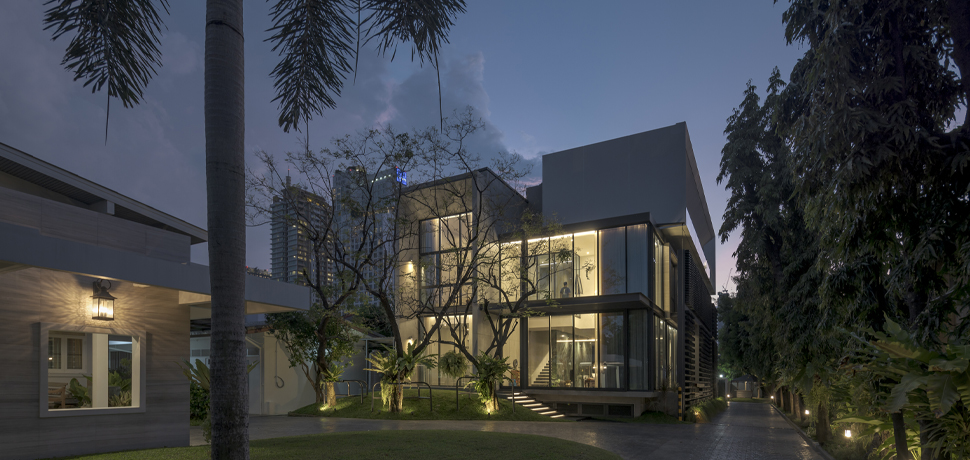
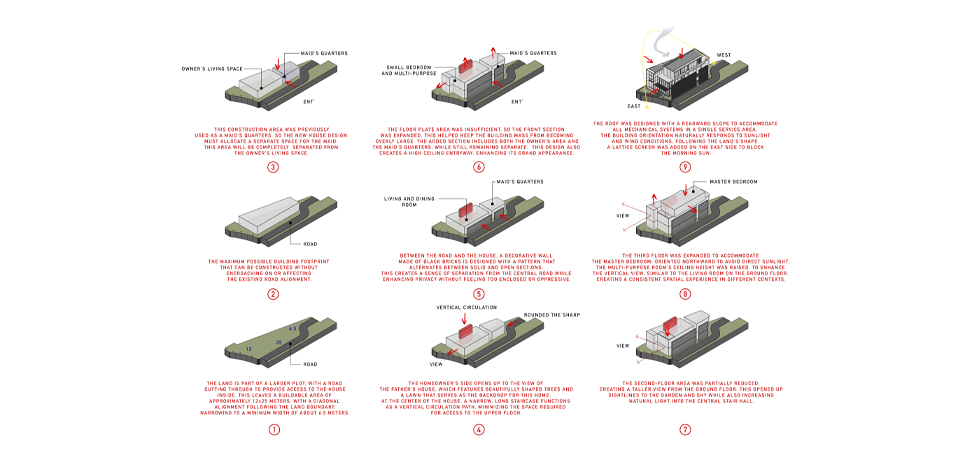
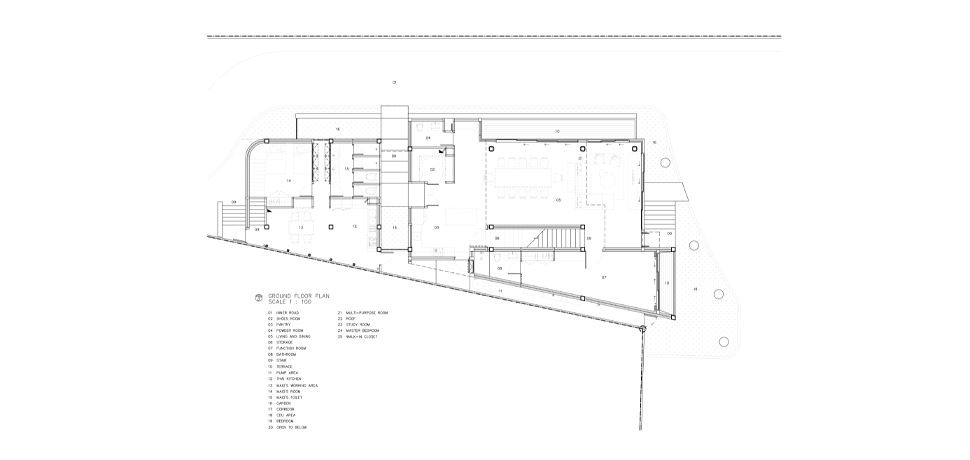

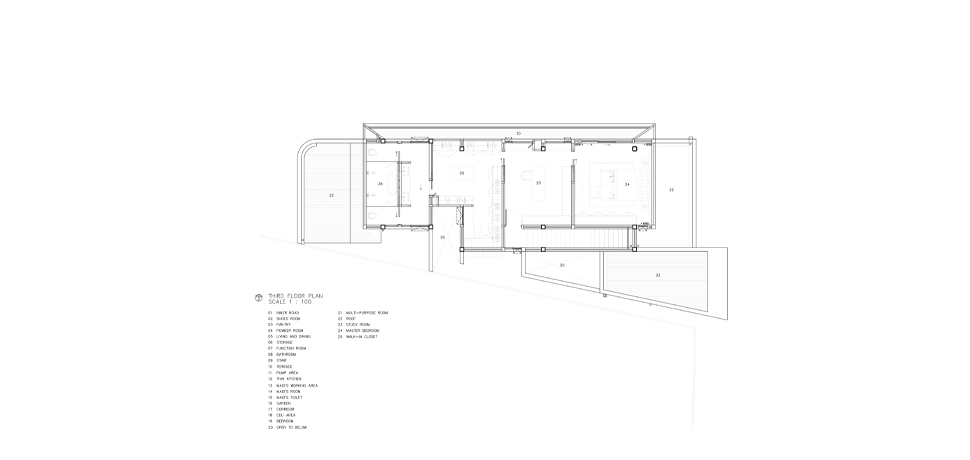
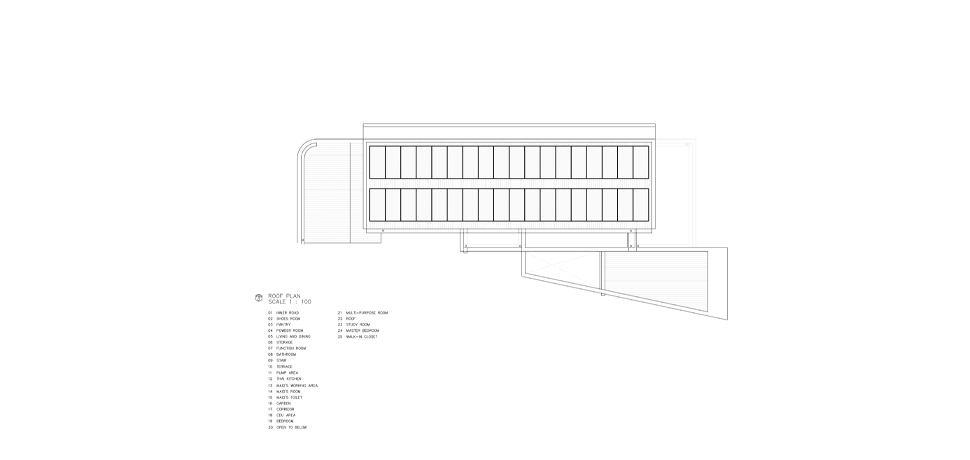
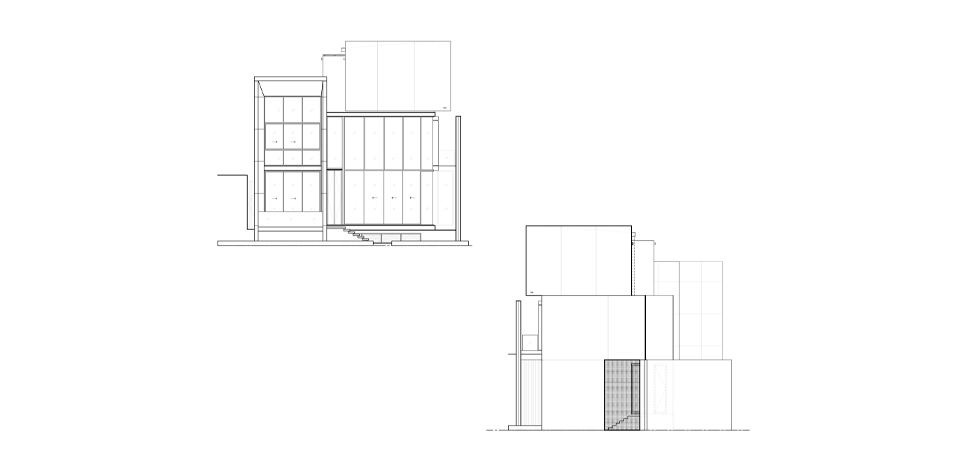
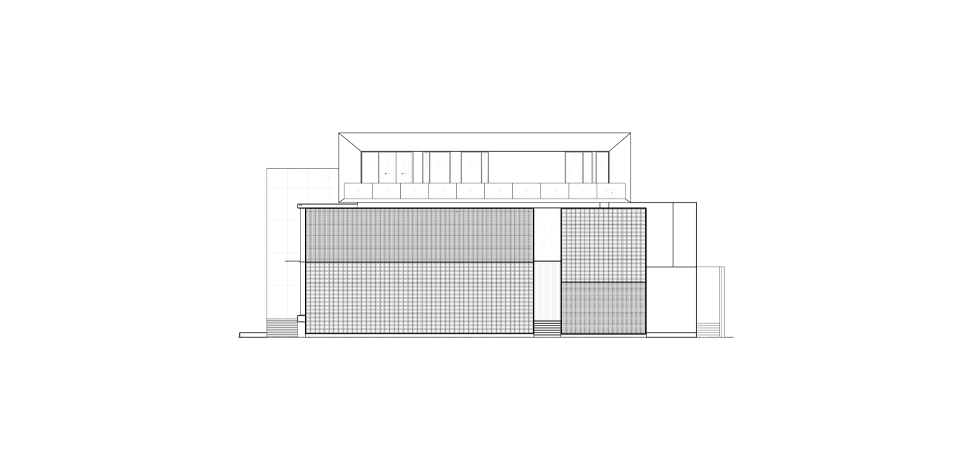
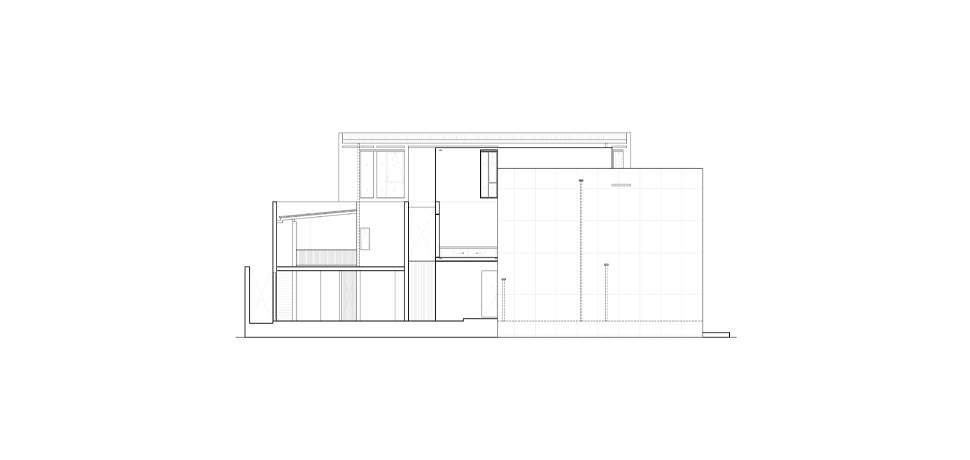

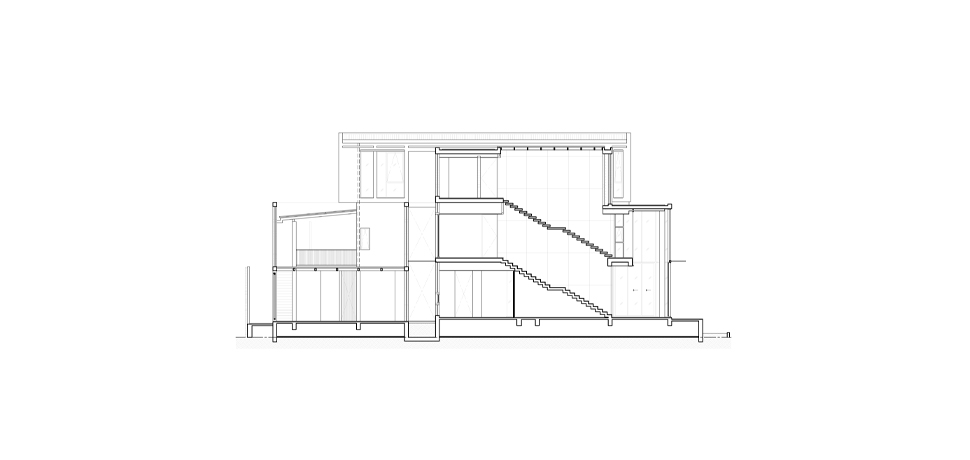
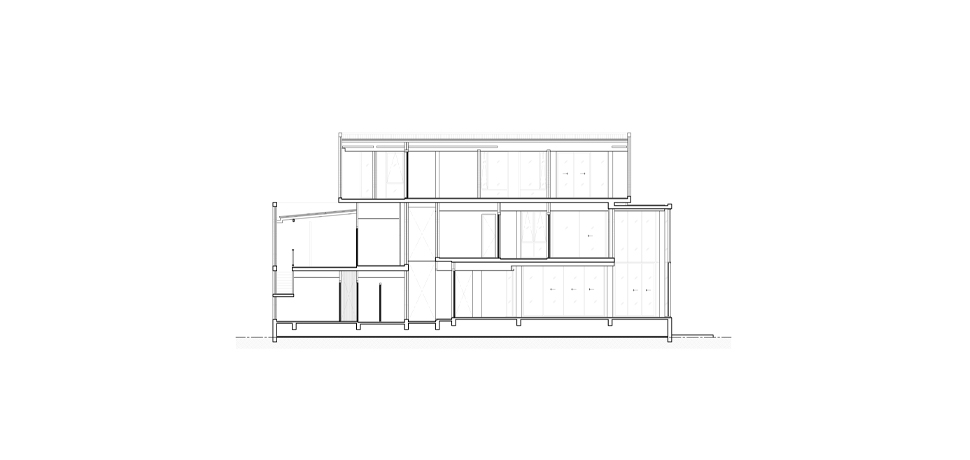
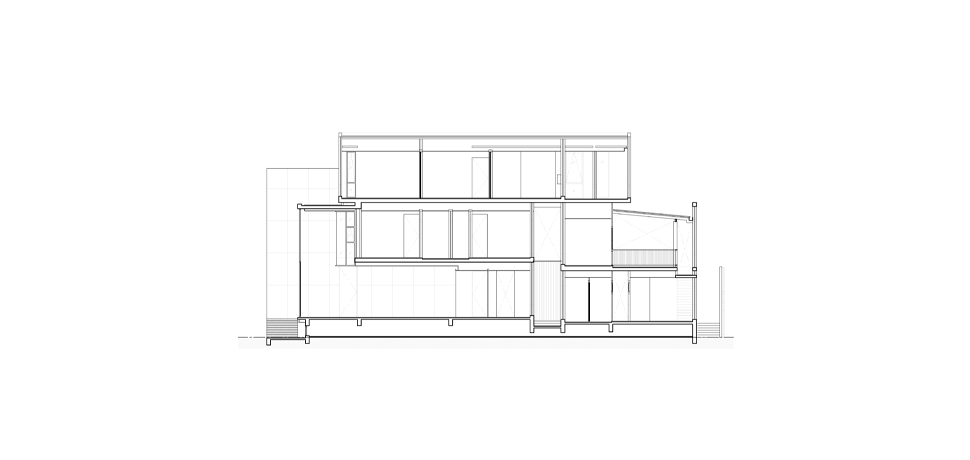
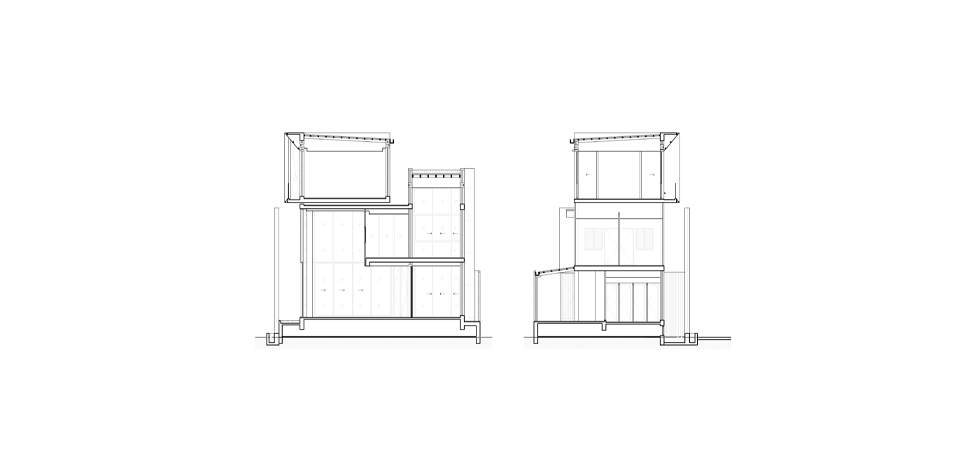
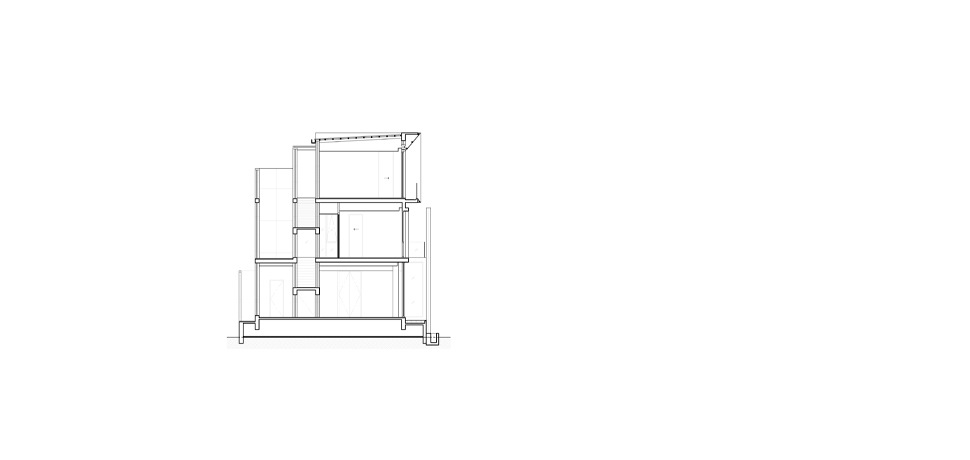
This residence is located in the heart of Bangkok, within a business district surrounded by older homes designed in a bygone era. These houses, with their
beautifully arranged geometric forms, are set amidst expansive lawns and large trees. This project occupies land where such homes once stood.
As time passed and the family grew, the homeowner’s father envisioned dividing part of the original property to build a new house for his children
and grandchildren, allowing them to establish their own families.
The new plot is situated at the entrance of the larger property and was previously used as a maid’s quarters. Upon surveying the land, the team found it
to be a relatively small trapezoidal site: 12 meters at its widest point, narrowing to 6.5 meters, and stretching 25 meters in length. Legal setback
requirements further reduced the available building area. At the front, the existing driveway to the original house had to be preserved without alteration.
Additionally, since the old maid’s quarters were demolished, a new space for the maid had to be incorporated into the design while maintaining privacy
and separation from the main living areas. These conditions posed a significant challenge for the design team.
To address this, the architects separated the homeowner’s and maid’s areas through the entrance. The maid’s quarters were designed with entirely solid
walls to block visibility, with softened corners responding to the street’s angular geometry. On the first floor, the homeowner’s spaces serve as
communal areas—including the living room, guest reception, and dining space—all oriented toward the lawn and trees of the father’s house.
A centrally placed staircase efficiently organizes circulation while minimizing wasted space. Along the roadside, a screen wall was introduced
for privacy between the street and the living area. This screen, built from black bricks arranged with alternating solid and open sections, reads
as a solid wall when viewed from the street, but from inside, residents can still look outward. Select openings allow controlled interaction
with the surroundings.
On the second floor, the homeowner’s spaces include two small bedrooms and a multi-purpose room, while the maid’s sleeping quarters
are elevated to this level for privacy. The entire third floor is dedicated to the master bedroom, oriented northward with openings that frame
views of the Bangkok skyline.
The primary views of the house are directed toward the lawn and large trees of the father’s property. Given the small plot size and tight urban
context, the design team sought to maximize openness through vertical windows and floor-to-ceiling heights in key areas such as
the living room and multi-purpose room.
This strategy enhances the sense of space while capturing views of the trees and sky. At the rear, utility and service areas were positioned for
ease of maintenance, keeping the main living spaces free from visual clutter. From the design team’s perspective, the project achieved highly
satisfying results. Despite the limited land, constraints, and dense surroundings, the layout strikes a careful balance—neither too compact
nor overly spacious. It ensures practicality, efficient maintenance, and avoids unnecessary complexity. This residence stands as a project
our office is particularly proud of.
Architects: Narucha Kuwattanapasiri, Kunatip Thonglueang, Siriprapa Prasompan
Interior Architect: NAWA Architects Co., Ltd.
Landscape Architect: –
Lighting Architect: –
Structural Engineer: Pongsakorn Soontranont
System Engineers: Sutida Sirimungkla, Tanakorn Eaksongkiat, Rawiwan Tiwawong
Contractor: Kor-It Design and Construction Co., Ltd.
Photographs: Soopakorn Srisakul


















































































































This residence is located in the heart of Bangkok, within a business district surrounded by older homes designed in a bygone era. These houses, with their
beautifully arranged geometric forms, are set amidst expansive lawns and large trees. This project occupies land where such homes once stood.
As time passed and the family grew, the homeowner’s father envisioned dividing part of the original property to build a new house for his children
and grandchildren, allowing them to establish their own families.
The new plot is situated at the entrance of the larger property and was previously used as a maid’s quarters. Upon surveying the land, the team found it
to be a relatively small trapezoidal site: 12 meters at its widest point, narrowing to 6.5 meters, and stretching 25 meters in length. Legal setback
requirements further reduced the available building area. At the front, the existing driveway to the original house had to be preserved without alteration.
Additionally, since the old maid’s quarters were demolished, a new space for the maid had to be incorporated into the design while maintaining privacy
and separation from the main living areas. These conditions posed a significant challenge for the design team.
To address this, the architects separated the homeowner’s and maid’s areas through the entrance. The maid’s quarters were designed with entirely solid
walls to block visibility, with softened corners responding to the street’s angular geometry. On the first floor, the homeowner’s spaces serve as
communal areas—including the living room, guest reception, and dining space—all oriented toward the lawn and trees of the father’s house.
A centrally placed staircase efficiently organizes circulation while minimizing wasted space. Along the roadside, a screen wall was introduced
for privacy between the street and the living area. This screen, built from black bricks arranged with alternating solid and open sections, reads
as a solid wall when viewed from the street, but from inside, residents can still look outward. Select openings allow controlled interaction
with the surroundings.
On the second floor, the homeowner’s spaces include two small bedrooms and a multi-purpose room, while the maid’s sleeping quarters
are elevated to this level for privacy. The entire third floor is dedicated to the master bedroom, oriented northward with openings that frame
views of the Bangkok skyline.
The primary views of the house are directed toward the lawn and large trees of the father’s property. Given the small plot size and tight urban
context, the design team sought to maximize openness through vertical windows and floor-to-ceiling heights in key areas such as
the living room and multi-purpose room.
This strategy enhances the sense of space while capturing views of the trees and sky. At the rear, utility and service areas were positioned for
ease of maintenance, keeping the main living spaces free from visual clutter. From the design team’s perspective, the project achieved highly
satisfying results. Despite the limited land, constraints, and dense surroundings, the layout strikes a careful balance—neither too compact
nor overly spacious. It ensures practicality, efficient maintenance, and avoids unnecessary complexity. This residence stands as a project
our office is particularly proud of.
Architects: Narucha Kuwattanapasiri, Kunatip Thonglueang, Siriprapa Prasompan
Interior Architect: NAWA Architects Co., Ltd.
Landscape Architect: –
Lighting Architect: –
Structural Engineer: Pongsakorn Soontranont
System Engineers: Sutida Sirimungkla, Tanakorn Eaksongkiat, Rawiwan Tiwawong
Contractor: Kor-It Design and Construction Co., Ltd.
Photographs: Soopakorn Srisakul


















































































































This residence is located in the heart of Bangkok, within a business district surrounded by older homes designed in a bygone era. These houses, with their
beautifully arranged geometric forms, are set amidst expansive lawns and large trees. This project occupies land where such homes once stood.
As time passed and the family grew, the homeowner’s father envisioned dividing part of the original property to build a new house for his children
and grandchildren, allowing them to establish their own families.
The new plot is situated at the entrance of the larger property and was previously used as a maid’s quarters. Upon surveying the land, the team found it
to be a relatively small trapezoidal site: 12 meters at its widest point, narrowing to 6.5 meters, and stretching 25 meters in length. Legal setback
requirements further reduced the available building area. At the front, the existing driveway to the original house had to be preserved without alteration.
Additionally, since the old maid’s quarters were demolished, a new space for the maid had to be incorporated into the design while maintaining privacy
and separation from the main living areas. These conditions posed a significant challenge for the design team.
To address this, the architects separated the homeowner’s and maid’s areas through the entrance. The maid’s quarters were designed with entirely solid
walls to block visibility, with softened corners responding to the street’s angular geometry. On the first floor, the homeowner’s spaces serve as
communal areas—including the living room, guest reception, and dining space—all oriented toward the lawn and trees of the father’s house.
A centrally placed staircase efficiently organizes circulation while minimizing wasted space. Along the roadside, a screen wall was introduced
for privacy between the street and the living area. This screen, built from black bricks arranged with alternating solid and open sections, reads
as a solid wall when viewed from the street, but from inside, residents can still look outward. Select openings allow controlled interaction
with the surroundings.
On the second floor, the homeowner’s spaces include two small bedrooms and a multi-purpose room, while the maid’s sleeping quarters
are elevated to this level for privacy. The entire third floor is dedicated to the master bedroom, oriented northward with openings that frame
views of the Bangkok skyline.
The primary views of the house are directed toward the lawn and large trees of the father’s property. Given the small plot size and tight urban
context, the design team sought to maximize openness through vertical windows and floor-to-ceiling heights in key areas such as
the living room and multi-purpose room.
This strategy enhances the sense of space while capturing views of the trees and sky. At the rear, utility and service areas were positioned for
ease of maintenance, keeping the main living spaces free from visual clutter. From the design team’s perspective, the project achieved highly
satisfying results. Despite the limited land, constraints, and dense surroundings, the layout strikes a careful balance—neither too compact
nor overly spacious. It ensures practicality, efficient maintenance, and avoids unnecessary complexity. This residence stands as a project
our office is particularly proud of.
Architects: Narucha Kuwattanapasiri, Kunatip Thonglueang, Siriprapa Prasompan
Interior Architect: NAWA Architects Co., Ltd.
Landscape Architect: –
Lighting Architect: –
Structural Engineer: Pongsakorn Soontranont
System Engineers: Sutida Sirimungkla, Tanakorn Eaksongkiat, Rawiwan Tiwawong
Contractor: Kor-It Design and Construction Co., Ltd.
Photographs: Soopakorn Srisakul
This residence is located in the heart of Bangkok, within a business district surrounded by older homes designed in a bygone era. These houses, with their
beautifully arranged geometric forms, are set amidst expansive lawns and large trees. This project occupies land where such homes once stood.
As time passed and the family grew, the homeowner’s father envisioned dividing part of the original property to build a new house for his children
and grandchildren, allowing them to establish their own families.
The new plot is situated at the entrance of the larger property and was previously used as a maid’s quarters. Upon surveying the land, the team found it
to be a relatively small trapezoidal site: 12 meters at its widest point, narrowing to 6.5 meters, and stretching 25 meters in length. Legal setback
requirements further reduced the available building area. At the front, the existing driveway to the original house had to be preserved without alteration.
Additionally, since the old maid’s quarters were demolished, a new space for the maid had to be incorporated into the design while maintaining privacy
and separation from the main living areas. These conditions posed a significant challenge for the design team.
To address this, the architects separated the homeowner’s and maid’s areas through the entrance. The maid’s quarters were designed with entirely solid
walls to block visibility, with softened corners responding to the street’s angular geometry. On the first floor, the homeowner’s spaces serve as
communal areas—including the living room, guest reception, and dining space—all oriented toward the lawn and trees of the father’s house.
A centrally placed staircase efficiently organizes circulation while minimizing wasted space. Along the roadside, a screen wall was introduced
for privacy between the street and the living area. This screen, built from black bricks arranged with alternating solid and open sections, reads
as a solid wall when viewed from the street, but from inside, residents can still look outward. Select openings allow controlled interaction
with the surroundings.
On the second floor, the homeowner’s spaces include two small bedrooms and a multi-purpose room, while the maid’s sleeping quarters
are elevated to this level for privacy. The entire third floor is dedicated to the master bedroom, oriented northward with openings that frame
views of the Bangkok skyline.
The primary views of the house are directed toward the lawn and large trees of the father’s property. Given the small plot size and tight urban
context, the design team sought to maximize openness through vertical windows and floor-to-ceiling heights in key areas such as
the living room and multi-purpose room.
This strategy enhances the sense of space while capturing views of the trees and sky. At the rear, utility and service areas were positioned for
ease of maintenance, keeping the main living spaces free from visual clutter. From the design team’s perspective, the project achieved highly
satisfying results. Despite the limited land, constraints, and dense surroundings, the layout strikes a careful balance—neither too compact
nor overly spacious. It ensures practicality, efficient maintenance, and avoids unnecessary complexity. This residence stands as a project
our office is particularly proud of.
Architects: Narucha Kuwattanapasiri, Kunatip Thonglueang, Siriprapa Prasompan
Interior Architect: NAWA Architects Co., Ltd.
Landscape Architect: –
Lighting Architect: –
Structural Engineer: Pongsakorn Soontranont
System Engineers: Sutida Sirimungkla, Tanakorn Eaksongkiat, Rawiwan Tiwawong
Contractor: Kor-It Design and Construction Co., Ltd.
Photographs: Soopakorn Srisakul




